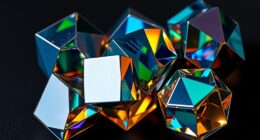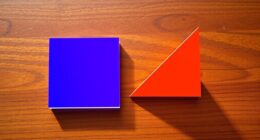Understanding similarity and congruence helps you see how geometric shapes relate through size, shape, and transformations. Congruent figures are identical in size and shape, while similar shapes have the same shape but different sizes, with sides proportional through a scale factor. Recognizing properties like matching angles and proportional sides shows how figures compare. When you explore how transformations preserve these relationships, you’ll gain a clearer picture of their importance in both math and real-life situations.
Key Takeaways
- Congruent figures have identical size and shape; similar figures share the same shape but differ in size, with sides proportional.
- Corresponding angles in similar and congruent shapes are equal; side lengths in similar figures are proportional via a scale factor.
- Transformations like rotations, reflections, and translations preserve shape and size (congruence) or shape with proportional sides (similarity).
- Recognizing symmetry and geometric properties helps in comparing and analyzing figures in real-world applications.
- Scaling and proportional reasoning enable understanding of size differences while maintaining shape relationships across figures.
Defining Similarity and Congruence in Geometry

Understanding the concepts of similarity and congruence is fundamental in geometry because they describe how shapes relate to each other. When shapes are congruent, they are identical in size and shape, meaning all angles and sides match exactly. Congruence relies on properties like angle bisectors, which divide angles into equal parts, helping identify identical angles in congruent figures. Similar figures, on the other hand, have the same shape but different sizes; their corresponding angles are equal, and sides are proportional. Symmetry properties play a role here, as they reflect how figures can be mapped onto themselves or each other through transformations, highlighting the core differences between similarity and congruence. Recognizing these distinctions helps you understand how shapes relate in various geometric contexts. Additionally, understanding water-based activities like hydrotherapy and aquatic exercises can enhance your overall grasp of how water influences physical properties and health benefits.
Key Properties That Determine Similar Figures
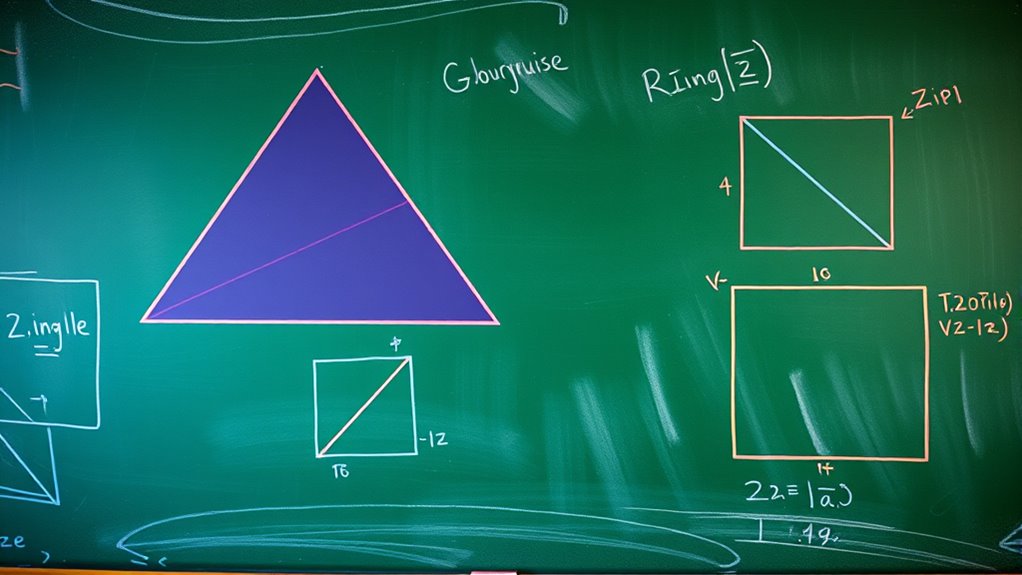
The key properties that determine similar figures revolve around the concepts of angle equality and side proportionality. When two figures are similar, their corresponding angles are equal, establishing angle correspondence. This means each angle in one figure matches the identical angle in the other, preserving shape. Additionally, the side lengths of similar figures are proportional, connected through a constant scale factor. The scale factor indicates how much one figure has been enlarged or reduced relative to the other. If you know the scale factor, you can determine all side lengths of a similar figure by multiplying the corresponding sides by this value. Together, angle correspondence and the consistent scale factor ensure the figures are similar, maintaining shape while allowing size differences.
Criteria for Congruent Shapes

To determine if shapes are congruent, you focus on their corresponding sides and angles. If these match exactly, the shapes are congruent through rigid transformations. Recognizing these criteria helps you quickly verify shape equality in various geometric problems. Additionally, understanding the properties of shape transformation can aid in visualizing how shapes can be manipulated without altering their congruence.
Corresponding Sides Equal
When two shapes are congruent, their corresponding sides are equal in length. This means each side in one shape matches a side in the other. To verify congruence, you can check the following:
- Measure the lengths of corresponding sides directly.
- Confirm that the perpendicular distances from a vertex to the opposite side are equal, indicating equal side lengths.
- Use angle bisectors to split angles; equal bisectors suggest corresponding sides are congruent.
- Ascertain that the sides are equal in length and that angles between them are also equal, supporting congruence.
- Understanding geometric relationships helps in comprehending how congruence is established through side and angle measurements.
Corresponding Angles Match
Since corresponding angles are equal in measure, matching these angles is a key criterion for establishing the congruence of shapes. Angle correspondence involves pairing angles from two shapes so that each pair has the same measure. When you identify matching angles, you’re confirming that the shapes have the same angle measurements at corresponding positions. Proper angle matching guarantees that the shapes are congruent because all corresponding angles are equal, and the sides between those angles are also equal in length. This criterion is often used in proofs and geometric reasoning to verify shape congruence. By carefully matching corresponding angles, you can confidently determine whether two shapes are congruent, based on the fundamental property that corresponding angles are equal in measure.
Rigid Transformations
Rigid transformations—such as translations, rotations, and reflections—are operations that move a shape without changing its size or shape. These transformations preserve congruence because they maintain properties like axial symmetry and rotational invariance. When a shape undergoes a reflection, it exhibits axial symmetry, meaning it looks the same when flipped across a line. Rotations demonstrate rotational invariance, where the shape remains unchanged after spinning around a point. Understanding these criteria helps you identify when two shapes are congruent through rigid transformations. Additionally, vetted Halloween product reviews can provide insights into themed costumes that often utilize these geometric concepts to create symmetrical and visually appealing designs.
Comparing Size and Shape: Practical Examples
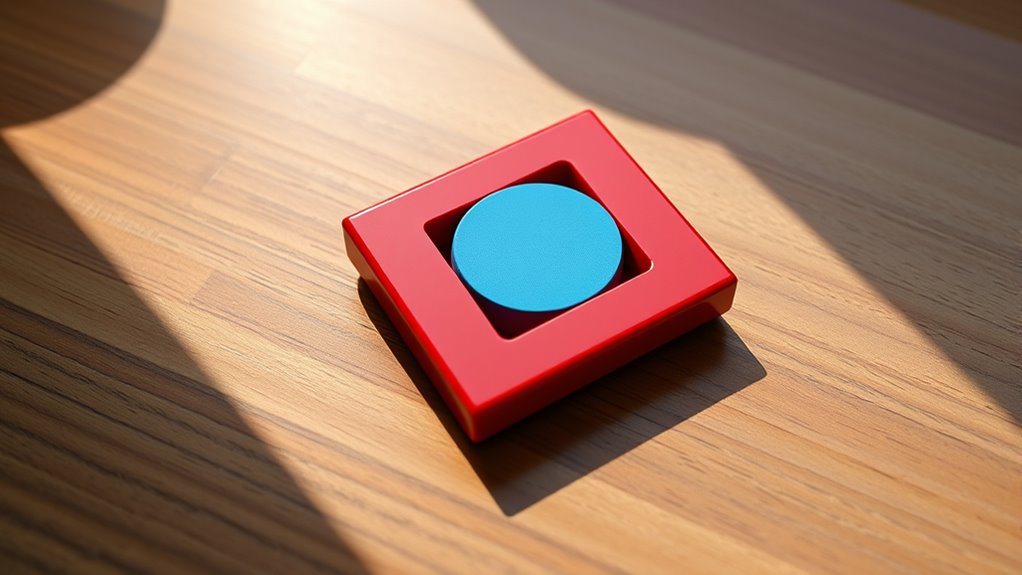
Understanding how scaling and proportions work helps you compare different shapes accurately. You can see similar figures in nature, like leaves or animal markings, that maintain shape but vary in size. By examining geometric shapes, you’ll notice how their size and form relate through practical examples. Recognizing geometric relationships can also improve your ability to analyze real-world structures and designs.
Scaling and Proportions
Scaling and proportions play a vital role when comparing the size and shape of objects in real life. You use scaling factors to determine how much an object’s size changes while maintaining its shape. Proportional reasoning helps you understand relationships between different measurements, such as lengths or angles. Understanding how to make organic and natural juices can also be related to precise measurements and proportions to ensure consistent flavor and quality.
Here are some practical examples:
- Adjusting a map’s scale to represent distances accurately.
- Creating scale models of buildings or products.
- Comparing photographs taken from different distances.
- Planning a garden layout using proportional measurements.
Similar Figures in Nature
In nature, many objects and organisms display similar shapes but differ in size, allowing us to compare and analyze them effectively. These similar figures often showcase natural symmetry, helping identify repeating patterns across scales. Fractal patterns are a prime example, where each smaller part resembles the whole, demonstrating self-similarity. You’ll notice this in coastlines, mountain ranges, and plant structures like fern leaves or snowflakes. Recognizing these similarities helps you understand how nature uses geometry to optimize functions like growth or resource distribution. By comparing these figures, you see how shape remains consistent despite size differences, highlighting the importance of similarity in natural design. These observations reveal the underlying geometric principles that govern the beauty and efficiency of natural forms. Educational toys can be useful tools for children to explore and understand these geometric relationships through hands-on activities.
Comparing Geometric Shapes
When comparing geometric shapes in everyday life, you can see how size and shape relate through practical examples. For instance:
- A soccer ball’s polygon symmetry shows how the same pattern repeats around a sphere, illustrating circle properties and symmetry.
- Coins of different sizes but similar shapes demonstrate how scale affects size while maintaining shape.
- Comparing a rectangular tablet and a smartphone highlights how shapes can be similar despite size differences.
- Recognizing that a circular plate and a wheel share circle properties helps you understand their geometric relationships.
- Observing the proportions of a farmhouse bed frame and vintage furniture reveals how proportional scaling maintains shape consistency across different objects.
These examples show how shapes like polygons and circles maintain their properties across different sizes. Observing polygon symmetry and circle properties helps you grasp the fundamental concepts behind comparing geometric shapes in real life.
Transformations That Preserve Congruence and Similarity
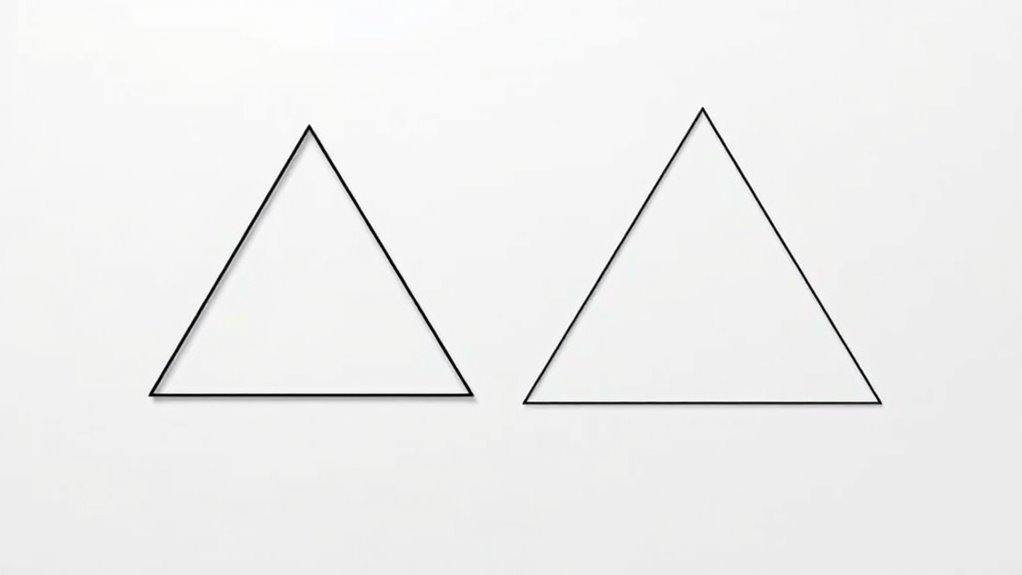
Transformations that preserve congruence and similarity are fundamental in understanding how figures can be moved or changed without altering their core properties. Rotational symmetry ensures a figure looks the same after a certain degree of rotation around a point, maintaining its shape and size. Glide reflection combines a translation with a reflection over a line, producing a movement that keeps the figure congruent to its original. Both transformations uphold congruence because they do not change the size or shape of the figures. When applied to similar figures, these transformations maintain proportionality and angles, ensuring the figures remain similar. These operations allow you to manipulate shapes confidently, knowing their fundamental properties stay intact. Understanding these transformations deepens your grasp of geometric relationships. Recognizing the importance of digital literacy can also enhance your ability to analyze and interpret geometric concepts in modern technology.
Real-World Applications of Geometric Relationships

Understanding geometric relationships is essential because they appear in many real-world situations, guiding design, construction, and problem-solving. In architectural design, you use similarity and congruence to create balanced, visually appealing structures. Artists rely on these concepts for art composition, ensuring proportions are harmonious. Here are some ways these relationships are applied:
- Designing buildings with proportional elements that maintain aesthetic harmony.
- Using scale models to visualize large structures accurately.
- Creating art compositions with consistent angles and ratios for visual impact.
- Planning renovations by matching new elements with existing structures through similarity principles. Additionally, understanding geometric relationships helps improve spatial reasoning skills, which are vital for effective problem-solving in various technical fields.
Frequently Asked Questions
How Can I Determine if Two Shapes Are Similar or Congruent Visually?
To ascertain if two shapes are similar or congruent visually, start by comparing their angles. If all angles are equal, the shapes might be similar or congruent. Next, look at their side length ratios; if the ratios are equal, the shapes are similar. For congruence, verify all corresponding sides are equal in length. Check for these similarities or congruencies carefully to understand their geometric relationship.
What Are Common Mistakes When Applying Similarity and Congruence Criteria?
You might feel confident, but don’t overlook common mistakes when applying similarity and congruence criteria. The misapplication of criteria often leads to errors, causing you to assume shapes are similar or congruent without proper evidence. Overlooked angle correspondence can secretly ruin your analysis, making you miss key details. Stay vigilant, double-check your angles and side ratios, and guarantee you’re applying the correct criteria to avoid these pitfalls and achieve accurate results.
Are There Any Shapes That Are Neither Similar nor Congruent?
You might wonder if there are shapes that are neither similar nor congruent. In shape classification, some figures, like a circle and a square, are neither similar nor congruent because they lack transformational invariance—they don’t match through scaling or rigid motions. These shapes don’t share the same angles, sides, or proportions, making them distinct. Recognizing these differences helps you understand the fundamental concepts of geometric relationships.
How Do Symmetry and Rotation Affect Similarity and Congruence?
Imagine rotating a triangle; symmetry effects come into play, showing how the shape might look unchanged or different. Rotation implications reveal whether the shape remains congruent—exactly the same—or just similar, meaning same shape but different size. Symmetry can preserve congruence, while certain rotations might change a shape’s orientation without affecting its size or angles. This helps you understand how these transformations influence geometric relationships.
Can Non-Euclidean Geometries Involve Similarity and Congruence Concepts?
In non-Euclidean geometries like hyperbolic geometry, the notions of similarity and congruence don’t function the same way as in Euclidean geometry. You’ll find that non-Euclidean transformations modify shapes differently, making it hard to define similarity or congruence directly. These transformations, particular to hyperbolic geometry, change angles and lengths, so the traditional concepts don’t apply straightforwardly, and you need new ideas to understand geometric relationships in this context.
Conclusion
Understanding similarity and congruence opens the secrets of geometric relationships, revealing how shapes relate and transform. Remember, these concepts are the keys to grasping the harmony hidden in every figure. Without them, geometry would be a puzzle missing its most essential pieces. So, embrace these ideas—like the compass guides the painter—because they shape not just shapes, but your entire understanding of the world around you.



